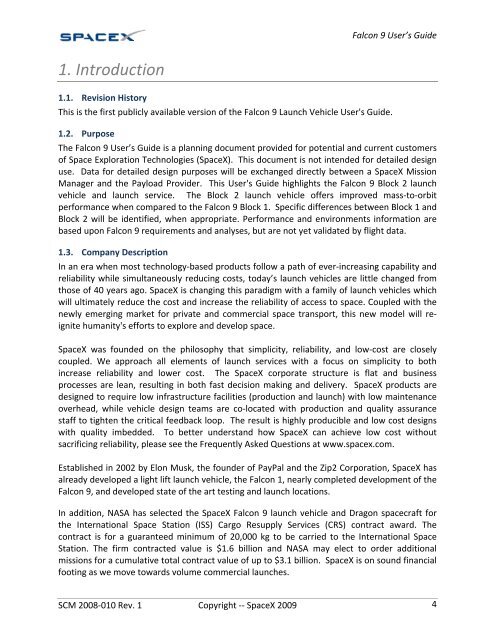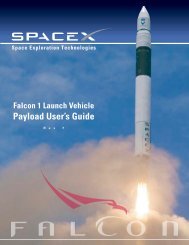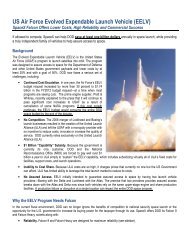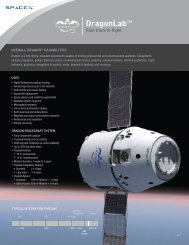Falcon 9 Launch Vehicle Payload User's Guide - SpaceX
Falcon 9 Launch Vehicle Payload User's Guide - SpaceX
Falcon 9 Launch Vehicle Payload User's Guide - SpaceX
Create successful ePaper yourself
Turn your PDF publications into a flip-book with our unique Google optimized e-Paper software.
1. Introduction<br />
1.1. Revision History<br />
This is the first publicly available version of the <strong>Falcon</strong> 9 <strong>Launch</strong> <strong>Vehicle</strong> <strong>User's</strong> <strong>Guide</strong>.<br />
<strong>Falcon</strong> 9 User’s <strong>Guide</strong><br />
1.2. Purpose<br />
The <strong>Falcon</strong> 9 User’s <strong>Guide</strong> is a planning document provided for potential and current customers<br />
of Space Exploration Technologies (<strong>SpaceX</strong>). This document is not intended for detailed design<br />
use. Data for detailed design purposes will be exchanged directly between a <strong>SpaceX</strong> Mission<br />
Manager and the <strong>Payload</strong> Provider. This <strong>User's</strong> <strong>Guide</strong> highlights the <strong>Falcon</strong> 9 Block 2 launch<br />
vehicle and launch service. The Block 2 launch vehicle offers improved mass‐to‐orbit<br />
performance when compared to the <strong>Falcon</strong> 9 Block 1. Specific differences between Block 1 and<br />
Block 2 will be identified, when appropriate. Performance and environments information are<br />
based upon <strong>Falcon</strong> 9 requirements and analyses, but are not yet validated by flight data.<br />
1.3. Company Description<br />
In an era when most technology‐based products follow a path of ever‐increasing capability and<br />
reliability while simultaneously reducing costs, today’s launch vehicles are little changed from<br />
those of 40 years ago. <strong>SpaceX</strong> is changing this paradigm with a family of launch vehicles which<br />
will ultimately reduce the cost and increase the reliability of access to space. Coupled with the<br />
newly emerging market for private and commercial space transport, this new model will re‐<br />
ignite humanity's efforts to explore and develop space.<br />
<strong>SpaceX</strong> was founded on the philosophy that simplicity, reliability, and low‐cost are closely<br />
coupled. We approach all elements of launch services with a focus on simplicity to both<br />
increase reliability and lower cost. The <strong>SpaceX</strong> corporate structure is flat and business<br />
processes are lean, resulting in both fast decision making and delivery. <strong>SpaceX</strong> products are<br />
designed to require low infrastructure facilities (production and launch) with low maintenance<br />
overhead, while vehicle design teams are co‐located with production and quality assurance<br />
staff to tighten the critical feedback loop. The result is highly producible and low cost designs<br />
with quality imbedded. To better understand how <strong>SpaceX</strong> can achieve low cost without<br />
sacrificing reliability, please see the Frequently Asked Questions at www.spacex.com.<br />
Established in 2002 by Elon Musk, the founder of PayPal and the Zip2 Corporation, <strong>SpaceX</strong> has<br />
already developed a light lift launch vehicle, the <strong>Falcon</strong> 1, nearly completed development of the<br />
<strong>Falcon</strong> 9, and developed state of the art testing and launch locations.<br />
In addition, NASA has selected the <strong>SpaceX</strong> <strong>Falcon</strong> 9 launch vehicle and Dragon spacecraft for<br />
the International Space Station (ISS) Cargo Resupply Services (CRS) contract award. The<br />
contract is for a guaranteed minimum of 20,000 kg to be carried to the International Space<br />
Station. The firm contracted value is $1.6 billion and NASA may elect to order additional<br />
missions for a cumulative total contract value of up to $3.1 billion. <strong>SpaceX</strong> is on sound financial<br />
footing as we move towards volume commercial launches.<br />
SCM 2008‐010 Rev. 1 Copyright ‐‐ <strong>SpaceX</strong> 2009 4





